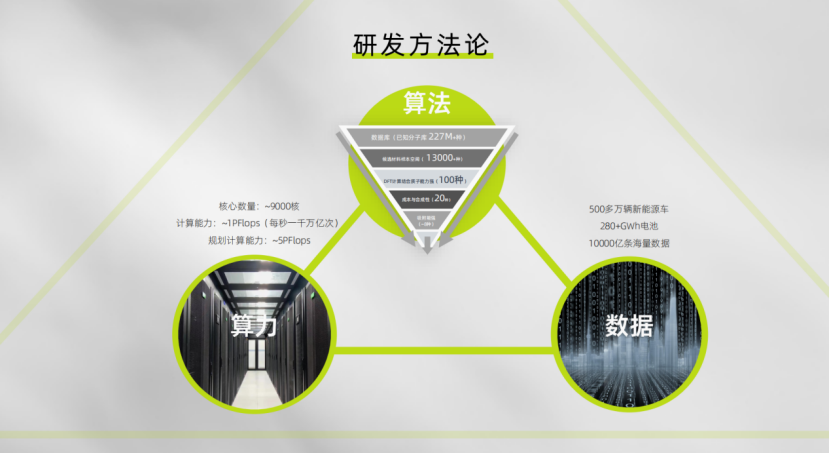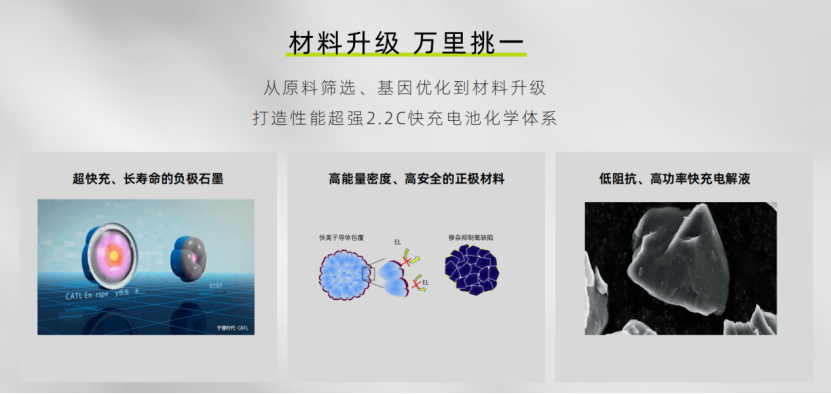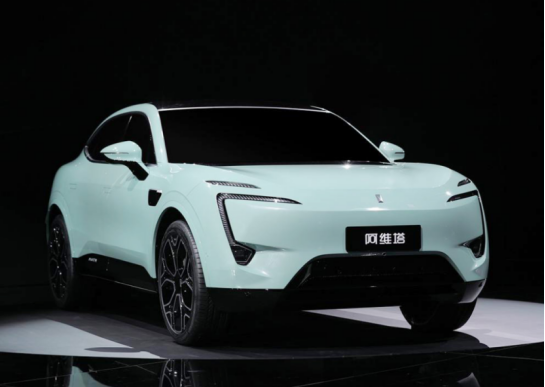AVITA 11, the result of collaboration between Changan Automobile, Huawei, and CATL, is about to be delivered.
As the “progeny” of investment, CATL naturally provides AVITA 11 with its best technology. The CTP2.0 (Cell to Pack, non-modular) battery system, which is the most advanced battery system produced by CATL, is installed in AVITA 11. In order to meet the needs of AVITA 11’s range and fast charging capabilities, CATL has carefully designed the battery system.
In order to ensure that the design of the AVITA battery pack is optimized, CATL used a large number of simulations to find the best cell chemical system during the development phase. Through material modification, CATL further improved the safety, lifespan, and fast charging performance of the battery cells. Finally, through system-level structural design, the safety and reliability of the battery system were further improved.
The meticulously designed CTP2.0 system is not inferior to the Kirin battery, which has not yet been mass-produced by CATL, in terms of performance and safety.
Development Phase: Simulation Platform Identifies the Best Solution
Why is “CATL” so technologically advanced?
Previously, it was widely acknowledged that CATL has an excellent team of talents. It was even jokingly said that half of the battery research scholars in China work for CATL.
Now, it is not just about the talents; CATL also has data.
As the world’s largest battery production enterprise, CATL has been ranked first in global production volume of power batteries for five consecutive years. An estimated one out of every four electric cars on the road uses CATL’s batteries.
Moreover, CATL established an early battery data collection and tracking system, accumulating massive actual application data of power batteries: over 5 million vehicles, 280 GWh of batteries, and 100 billion data points.
One of the uses of this data is to support CATL’s research and development. Previously, based on electrochemical principles and laboratory experiments, battery companies could also provide their best combination of battery materials, encapsulation patterns, and battery pack. However, the performance of this combination in application often reveals unexpected situations. It is also possible that the design performance and application scenarios do not match. For example, previous R&D emphasized the cycle life under full charge and discharge conditions, but actual application data showed that almost all car owners use the battery in the middle of its charge level, so what should be strengthened is the cycle life under relatively shallow charge and discharge.
With this feedback from actual application data, it is possible to better judge what combination is the best solution and provide a guarantee for the success rate of research and the precision of improvement.
Based on this data, CATL established a high-throughput computing platform.
Xiang Yanhuo, General Manager of CATL’s China Passenger Vehicle Solutions Department, introduced that CATL’s computing platform can integrate the material gene database platform with product development and application, and combine some process characteristics in production and manufacturing to provide the best product design scheme, enabling the product to be sufficiently fast, accurate, and perform excellently.
When it comes to the battery pack of R&D Aiwattah 11, Ningde Times not only draws on its rich experience in battery design, development, and production, but also utilizes big data accumulation, large computing power calculation, and artificial intelligence technology-assisted analysis. Ningde Times will first use simulation calculation platform for calculation and optimization, screen out the most potential formulas and compounds.
The results of simulation calculation will be verified by accumulated data, greatly reducing the probability of errors in the Aiwattah battery system.
It can be said that at the level of the R&D methodology, Aiwattah 11 battery pack has won on the starting line.
Battery Cell: Material modification, balancing safety, lifespan, and fast charging
From the beginning of the design, the goal of the battery system of Aiwattah 11 was to increase the range by 200 kilometers after charging for 10 minutes.
It is not difficult to achieve this goal alone, but it is difficult to achieve safety and long lifespan while supporting fast charging, which requires optimization design from the material level of battery cells.
Generally speaking, the negative electrode is responsible for fast charging; the positive electrode is responsible for energy.
For the negative electrode, Ningde Times has constructed a lithium-ion fast transmission channel on the surface of graphite materials, which improves the charging capacity of graphite negative electrodes, while balancing high energy density and good lifespan.
For the positive electrode, Ningde Times uses nano-rivet technology to connect the microstructure of materials like rivets together, ensuring the stability of materials and safety under high energy densities.
Regarding the material system of positive electrodes, Ningde Times has achieved an energy density of 245Wh/kg for the typical nickel-cobalt-manganese formula NCM523 through a series of optimizations, which is better than NCM811 batteries in terms of intrinsic safety.
The electrolyte is the path for lithium-ion migration between positive and negative electrodes. If the path is not wide or straight enough, it may affect the rate of lithium-ion migration—i.e. charging and discharging speeds, and may also cause excessive temperature rise, leading to safety hazards.
Ningde Times has adopted a new type of electrolyte for the battery cells used in Aiwattah. This type of electrolyte can construct an efficient three-dimensional conductive network inside the electrode, which is equivalent to a high-speed highway for lithium ions, reducing the internal resistance and heat generation of the battery cells, improving the charging and discharging rate, and making the materials more stable.

On the premise of ensuring safety, Ningde Times has created the first domestically produced high-voltage ternary system 2.2C fast-charging battery for Aiwattah, which is almost twice as fast as the mainstream 1.2C fast-charging battery. Under normal temperature, charging for 10 minutes can increase range by 200 kilometers, and it also performs excellently at low temperatures.According to Xiang Yanhuo, this battery can quickly recharge from zero to full charge in 60 minutes, even in low-temperature environments such as 10 degrees Celsius below zero in the northern region.
From a design perspective, the CATL team developed excellent products for the Avita 11.
However, stable mass production capability is required to implement this series of sophisticated designs. In terms of quality control, CATL has set up more than 6,000 quality control points, and real-time data is uploaded to the platform, which can meet more than 20 years of traceability, making the product’s quality trustworthy.
In terms of battery manufacturing, CATL has passed the threshold of PPM (one-millionth) level defects and is striving to achieve PPB (one-billionth) level extreme manufacturing.
At the cell level, the battery used in the Avita 11 has no weaknesses in energy density, fast-charging performance, and safety, and its comprehensive capabilities can challenge all competitors.
System: NP technology boosts safety again
With no module, the cell does its job, and the rest of the work is left to the battery system.
The Avita 11 uses CATL’s CTP2.0 battery system technology, which is the most advanced and mature technology in CATL’s mass-produced battery packs.
The most outstanding feature is the thermal management system established to ensure safety.
To meet the fast charging speed of 2.2C, CATL has specially developed a multi-channel and intelligent thermal management platform for the Avita battery pack. During the battery system operation, the temperature can be controlled within a temperature difference of 3 degrees Celsius.
With more channels, the heat dissipation efficiency will naturally increase, and the temperature rise will remain consistent, the consistency of the battery will be maintained, and the battery pack’s lifespan will be extended; intelligent sensors and monitoring systems will monitor the cell temperature, control the water cooling system to precisely cool the cells, keeping the temperature between the cells stable at the most appropriate level, which helps eliminate safety hazards and lengthen the lifespan of the battery pack.
What if a thermal runaway occurs?
The Avita 11 battery pack also has a double-layer insurance strategy of isolation first and discharge later for unexpected situations.
The cells are separated by aviation-grade insulation materials, which can withstand high temperatures of nearly 1000 degrees Celsius. Even in the case of a single cell failure, it will not cause a chain reaction of surrounding cells, greatly improving the overall battery pack’s safety.
At the same time, through a three-dimensional simulation of the gas diffusion path when the cell fails, optimized exhaust channels are designed in the battery pack, and a large-capacity pressure relief valve is used. In case of an accident, the high-temperature airflow can be quickly discharged, reducing the risk of the battery pack rupturing due to increased internal pressure.In the process of discharging high-temperature airflow, the design of the commutation channel needs to be extremely ingenious. It is necessary to not only control the flow of heat along the predetermined trajectory, but also to control the distribution of heat as evenly as possible in different structural channels to reduce the thermal impact on adjacent batteries and avoid secondary thermal runaway.
In addition, the high-voltage connections and high-voltage safety areas in the battery pack also use high-temperature insulation protection design to ensure that these high-voltage components and connection areas can withstand high-temperature testing.
Of course, this is the response measure taken when the battery cell experiences thermal runaway. In fact, Ningde times monitors the battery system 24/7. If any abnormal situation occurs, an alarm signal can be sent out within 30 seconds and intelligent preventive measures are taken.
In terms of safety, Ningde times has designed every detail of the battery pack for the Aveta 11, leaving nothing to chance.
CTP2.0: The Best Choice is the Most Suitable
Although Ningde times has introduced the concept of the Kirin battery, CTP2.0 is still the best choice for car companies for now and for a long time to come.
Let’s review what changes have happened to Ningde times’ successive CTP technologies?
In 2019, Ningde times proposed the CTP1.0 technology. Compared with the traditional solution from battery cell to module and then to the system, the Aveta 11 is a typical representative. With the dual motor all-wheel drive system, the models with 90-degree and 116-degree electricity have a cruising range of 555 kilometers and 680 kilometers respectively. It is said that the models with 700+ kilometers range will be launched in the future. In addition, the battery cell uses the 523 nickel and manganese formula and the bottom water cooling solution, and the safety of the battery has been fully verified in practice.
In 2022, Ningde times introduced the concept of the Kirin battery. Based on the CTP2.0 technology, the structure is further optimized and equipped with high-nickel ternary battery cells. The theoretical cruising range of pure electric vehicles can be increased to 1000 kilometers.
However, everything has two sides. Longer range requires more electrical capacity. If the charging efficiency is not improved, the charging time will become longer. Therefore, the Kirin battery uses 4C charging technology to solve the problem of charging time. But the improvement of the cooling system is required to solve the heat dissipation problem, and the heat exchange area is increased four times.
The question is, do electric vehicles really need a cruising range of 1000 kilometers?
On the one hand, data shows that in big cities like Beijing and Shanghai, the daily commute distance is within 70 kilometers. A cruising range of over 500 kilometers is sufficient to meet one week’s travel needs, and the range anxiety problem has been greatly relieved.The evolution of mobile phone batteries can be used as a reference. In the era of feature phones, Nokia could easily last a week on a single charge, but now with smartphones, daily charging is acceptable. Similarly, it can be predicted that with the great alleviation of user anxiety, the era of electric car range wars will come to an end, to be replaced by competition on the level of intelligence.
On the other hand, cost is also a key factor in car manufacturers’ decision-making. Even for models with optional Kirin batteries, it is unlikely that range will simply be stacked up to 1000 kilometers. After all, higher range means higher cost, and corresponding market potential will be reduced.
The development of any car product will go through several years of research and development and production time. The battery is only one component, and it is undoubtedly wise for the Avita 11, which will be delivered at the end of the year, to choose CTP2.0 technology: leading technology, mature and reliable quality, and production rhythm completely matching.
The newest is not necessarily the best, only through market tests can the most suitable one be found. When Kirin batteries go from concept to mass production and their quality and technology are fully verified by the market, there is no doubt that Avita will also mass-produce electric vehicles with Kirin batteries. After all, CATL is also a shareholder of Avita, and it is Yuqun Ceng’s personal statement to use the best batteries on Avita.
——END——
This article is a translation by ChatGPT of a Chinese report from 42HOW. If you have any questions about it, please email bd@42how.com.
